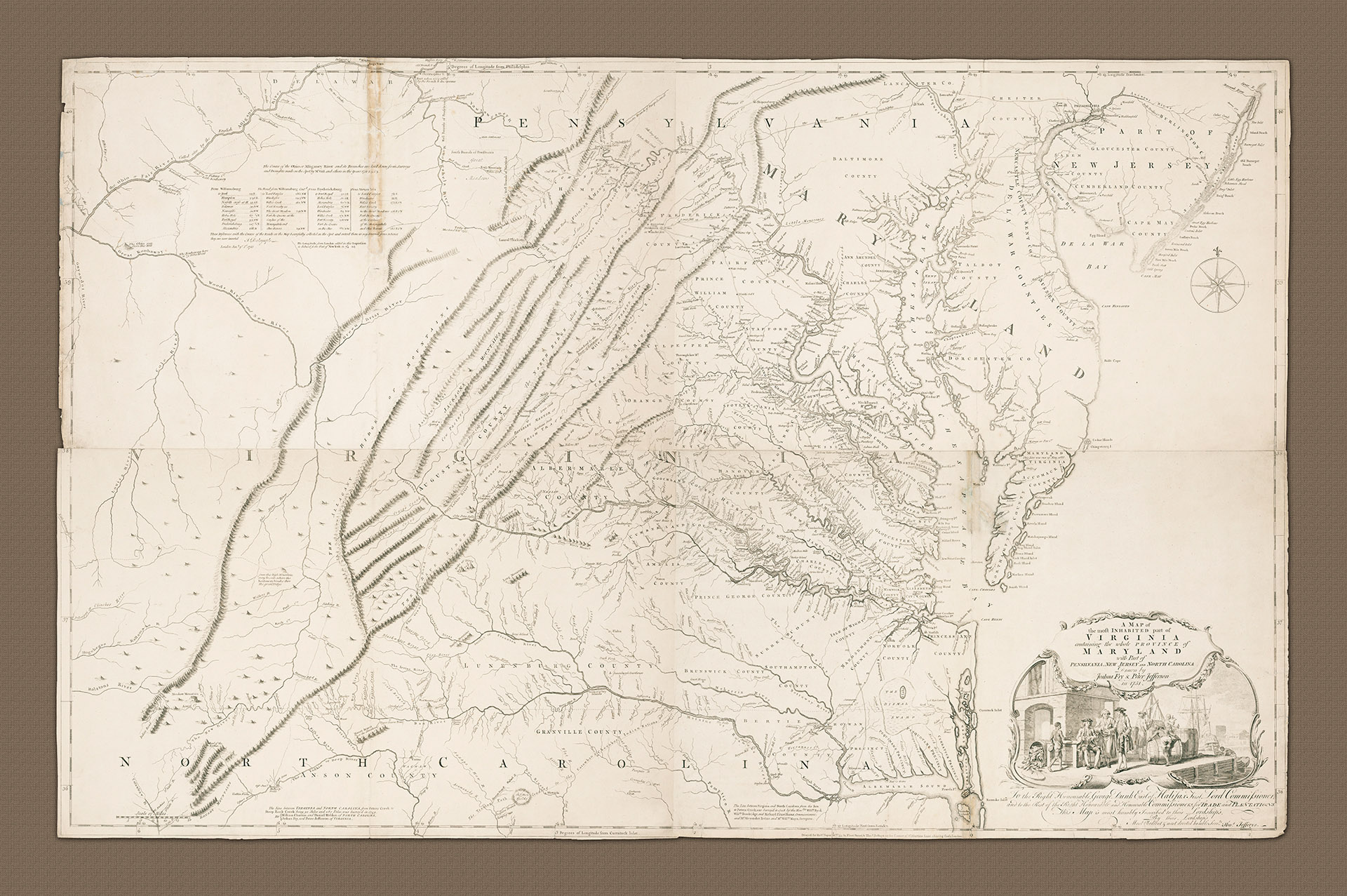
A312 - A map of the most inhabited part of Virginia
Fully titled 'A map of the most inhabited part of Virginia containing the whole province of Maryland with part of Pennsylvania, New Jersey and North Carolina' this beautiful map was surveyed by Joshua Fry & Peter Jefferson in 1751, published by Thos. Jefferys, London, 1755. It is one of the most important American maps of the 18th Century.
- 1751
- Joshua Fry and Peter Jefferson. Published by Robert Sayer & Thomas Jeffreys
- h36" x w54"
- L
By 1750 the British, motivated by recent encroachment on the Virginia frontier by the French, determined that more accurate surveys of their territories were needed. George Montagu Dunk, Earl of Halifax and President of the Board of Trade, asked the colonies for more information about activities on the frontiers. Lewis Burwell, acting Governor of Virginia, responded by commissioning Joshua Fry and Peter Jefferson (father of future President Thomas Jefferson) to prepare a map of the colony.
Fry and Jefferson were experienced surveyors who had worked together in determining the boundaries of Lord Fairfax's lands in 1746. They had also acted as joint commissioners to extend the western portion of the Virginia - North Carolina boundary line in 1749, and were surveyors for Albemarle County, a recently created county in Virginia's Piedmont region. They set-about their work in 1750 and in 1751 presented it to Acting Governor Burwell who forwarded it on to London together with full a description of Virginia's boundaries and back settlements, compiled by Fry, along with a brief account of the travels of John Peter Salley, a German man living in Augusta County.
The finished map was presented to the Commissioners of the Board of Trade and Plantations in London in March 1752. The Board of Trade paid Jefferson and Fry £150 each, and their work became the property of the English government. The map was then passed on to Thomas Jefferys (snr), a prolific publisher and engraver and geographer to the Prince of Wales who engraved the map on four copperplates in Summer 1753. The first edition of the Fry and Jefferson map was entitled 'A map of the inhabited part of....'. It was not until the second edition was released by Jeffreys in 1754 that the title was changed to 'A map of the most inhabited parts of...'. This state of the map contains major revisions, the most significant being the corrected course of the Ohio River, based on the additional information provided by surveyor and explorer Christopher Gist (see top left corner of map).
The edition presented here is likely a fourth state of the map. On the 6th edition of the map Jefferys changed the date in the main cartouche from 1751 to 1775. Robert Sayer is credited at the bottom of the sheet, probably as the printer.
The map Fry and Jefferson had produced relied on a combination of previous surveys completed by the two men along with a great deal of new surveys completed especially for this map. It is the first map to accurately depict the Blue Ridge Mountains and the first to lay down the colonial road system of Virginia. This included McCulloch's Path which was an early colonial route through Western Maryland and which owed its origin to American Bison.
The map affords an interesting illustration of the fact that the pioneers of the West were greatly indebted to the buffalo for their first passageways. The map also includes 'The Great Road from the Yadkin River through Virginia to Philadelphia distant 455 Miles', later to be known as 'The Great Philadelphia Wagon Road'. Also marked on the map is the Trading Path leading to the Catawba & Cherokee Indian Nations. The map is further distinguished for its accurate depiction of the Allegheny Mountains.
As with so many great works of art, literature or cartography this map reveals more and more with every viewing. The beautiful cartouche down in the bottom right corner of the map was designed by artist and engraver Francis Hayman who was a popular historical painter and a founding member of the Royal Academy in London. Charles Grignion was commissioned to design and execute the cartouche. which depicts a wharf scene in which a tobacco planter negotiates with a ship's captain, whist slaves attend and work on the dock-side of what is clearly a busy and prosperous harbour. An inventory is being checked indicating order and control. All appears harmonious and happy right down to the depiction of contented slave workers.
Virginia's economic dependence on tobacco, and slavery, is clearly visible. The major rivers in the Chesapeake area, along with their tentacle-like tributaries which reached far into the heartland of the State meant that goods could be transported to the major ports and harbours quickly and inexpensively, rather than by overland routes. This water-based transport system also allowed the larger plantation owners to negotiate with the ships captains from their plantation docks.
- A map of the most inhabited part of Virginia


